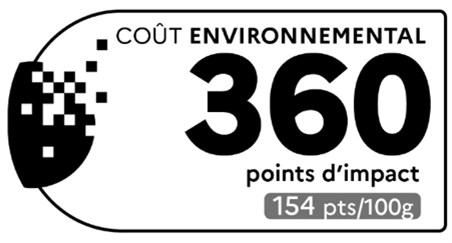Home – Regulations – The French Eco-Score Explained: Understanding What This Means for Your Products
The French Eco-Score Explained
Understanding what this means for your products
1 October 2025

Home – Regulations – The French Eco-Score Explained: Understanding What This Means for Your Products
Understanding what this means for your products
1 October 2025

The French Eco-Score (Coût Environnemental) is a display of a product’s environmental impact across its lifecycle, linked to the French law “Climat et Resilience” and Decree no.2025-957, which came into effect on 1st October, 2025.
It provides a cumulative score of the environmental cost of a product, enabling consumers to make informed, comparative and conscious purchasing decisions. It can also be used as a tool for textile producers to develop products with lower environmental impacts, higher durability and become a competitive choice for consumers.
The Eco-Score will apply to all manufacturers, distributors and importers placing textile products on the French market. There is no threshold for company size or revenue.
Apparel products currently in scope for the calculation of a score include new and remanufactured:
L’ADEME, the French Agency for Ecological Transition, is currently assessing the expansion to include additional textile categories. This expansion could see the addition of bras and bedding, but also non-textile categories, including furniture and cosmetics.
Certain product categories are currently excluded such as:
The label is currently voluntary for all, except for those who already communicate one or more environmental impacts of their products on their website or on the product at the point of sale.
An environmental impact label references a quantitative measurement of the impact of a product on different environmental categories.
This might include, for example:
The legislation came into force on October 1st, 2025.
Brands with existing environmental impact labelling need to register on the Ecobalyse portal and calculate their scores. All other brands can voluntarily follow these steps. Brands will have exclusivity to measure and display their scores on the portal for 1 year.
After October 1st, 2026, third parties (independents, NGOs, consultants, etc.) will be able to measure and publish the Eco-Score for any brand’s product, without prior approval from the brand. Brands are not required to publish this score on their website or products, but it will be available.
The score must be available for the consumer either in physical or digital format e.g. as a QR code, to ensure data on products can be updated regularly. Only the product ID, calculation date and score will be publicly visible.

Each product SKU will get a simple graphic of its impact displayed as a cumulative number. A higher score indicates a higher environmental impact. It also must be registered on the Ecobalyse portal.
Whilst the Eco-Score is mostly aligned with the Product Environmental Footprint Category Rules (PEFCR) for Apparel and Footwear, looking at the 16 environmental impact categories such as climate change, water use, eutrophication, it is essentially a simplified LCA methodology, and one we know about here at Anthesis, having been part of the team that worked on the PEFCR Rules for Apparel.
| Climate change | Eutrophication, terrestrial |
| Ozone depletion | Eutrophication, freshwater |
| Human toxicity, cancer | Eutrophication, marine |
| Human toxicity, non-cancer | Ecotoxicity, freshwater |
| Particulate matter | Land use |
| Ionising radiation, human health | Water use |
| Photochemical ozone formation, human health | Resource use, minerals and metals |
| Acidification | Resource use, fossils |
It also includes additional topics such as emotional durability (also known as extrinsic durability) and the export of textile waste outside the EU. Whilst we won’t delve too much into the methodology here, it’s important for brands to understand there are areas where it differs from the PEFCR – get in touch if you want to know more details on this.
Whilst this label is voluntary, if you are making environmental impact claims, this decree gives you the tools to make directly comparable claims with other brands.
Once brands start communicating in the same way this enables customers to understand clearly why and how your products are better than those of your competitors – giving brands that are doing the right thing the edge that they should get for making better products – as well as a competitive advantage perhaps at the point of sale, with Amazon recently noting that products with their Climate Pledge Friendly certification get a sales boost of 12.5% over non certified products.
It is also worth understanding that after the first year, any third party (e.g. NGOs, retailers) may publish a score for your products using publicly available data. When certain data points are missing, Ecobalyse automatically applies default values that are conservative and could increase the Environmental Cost of your products. If you publish scores yourself, you can stay in control of how your product’s impacts are communicated, always putting your best foot forward.
In the coming years, we expect this approach and labelling will align with the EU PEF methodology, which we expect to be used for the Ecodesign for Sustainable Products Regulation (ESPR). This is a great opportunity to prepare your business and test your systems for ESPR compliance.
Whilst the Eco-Score is not directly comparable to the Ecodesign for Sustainable Products Regulation (ESPR) regulations, the informed reader will notice a lot of similarities. So, before ESPR is fully adopted in 2027, the Eco-Score decree will give brands an opportunity to ensure their readiness while minimising disruptions, potential fines from ESPR non-compliance and missing out on commercial opportunities caused by delays in communicating product impacts.
Firstly, and urgently, check whether you are making any claims that would be defined as a quantitative measure of environmental impact. If so, Anthesis can support you to activate your business to comply with the Eco-Score – we can help you to understand the regulations and whether you need to comply. We can support you by looking at your data, your claims and even your LCA calculations.
We can support you with:
Discover how Anthesis can support you with your environmental claims, data, and LCA calculations to ensure you meet regulatory requirements.